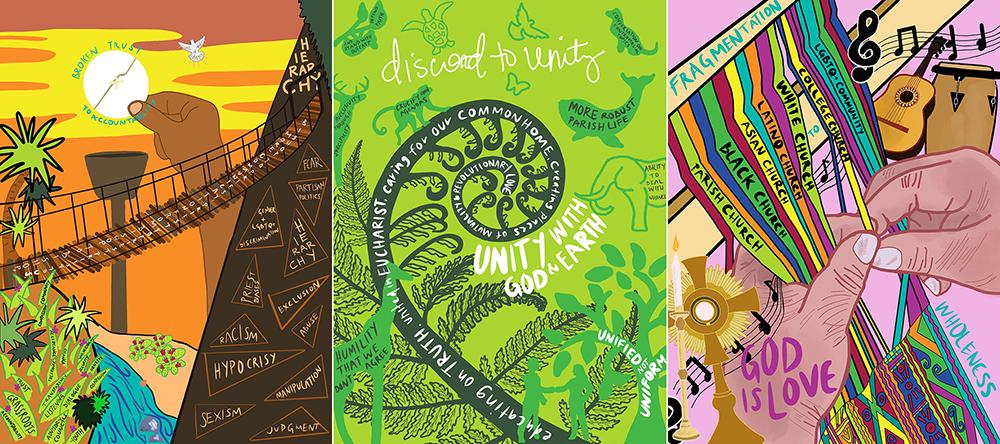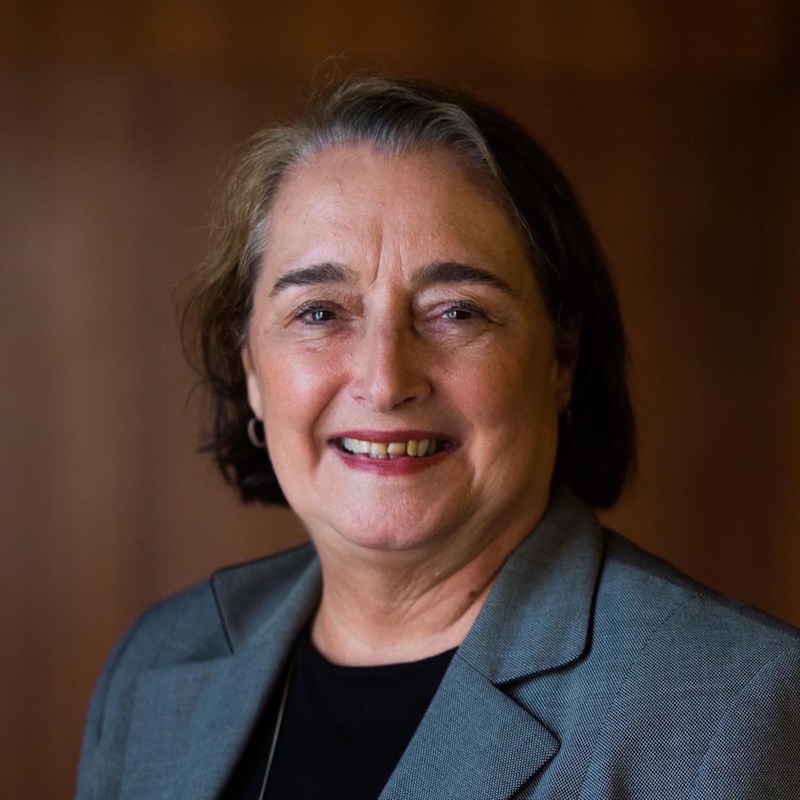One Month Out
Of course, you know what I mean. The Synod. I have been collecting articles but not writing about them, so today you get a smorgasbord of summaries that might set you searching for one or two that sparks your interest.
Claire Giangrave for Religion News Service in NCR summarizes the state of the women’s ordination question by effectively staging a debate between Miriam Duignan, co-director of Women’s Ordination Worldwide and long-term contributor to the Wijngaards Institute, and Casey Stanton, the founder and co-director of Discerning Deacons.
I am especially glad to see the lead illustration, three more pages of the digital art pieces created by Becky McIntyre after Philadelphia-area higher education Synodal listening sessions.

Setting the stage for this debate, Giangrave quotes Sr. Nathalie Becquart, undersecretary at the Vatican’s synod office: “For the Catholic Church at this moment, from an official point of view, it’s not an open question.” Giangrave – usefully, if you need it – recites the history of that official discussion, but she seems to accept the position of the other two that women’s ordination — to something — is indeed possible.
The Vatican’s “instrumentum laboris,” or working document that frames the discussion at the synod, asks the question is: “Most of the Continental Assemblies and the syntheses of several Episcopal Conferences call for the question of women’s inclusion in the diaconate to be considered. Is it possible to envisage this, and in what way?”
Giangrave lets Duignan evaluate the strategy operating against those favoring women priests:
Attributing the question to the continental assemblies and avoiding the words “ministry” and “ordination” in asking it, said Miriam Duignan, constituted a “preemptive strike” against open discussion of priestly [emphasis added] ordination.
Stanton argues that creating women deacons is “at the heart of the synod,” though I would say, perhaps not for everyone. If such a decision were taken it would be “a step forward that is meaningful, and one that people can see and feel in their communities.” I think that’s very important. It would be, all of us need to acknowledge. It would move women’s involvement to people, beyond argument. Like seeing RCWP and other ordained women.
Not that doing that would be uncomplicated, of course. I’ve seen it suggested that bishops could decide diocese by diocese, for example. Like the initial spotty acceptance of women priests in Episcopal and Anglican churches? Eventually a schism?
Of course, some women’s ordination advocates have been planning for October since the Synod was announced. Even Massimo Faggioli documents that.
Progressive Catholic movements with an agenda for change (for instance, promoting women’s ordination) are also not represented in any significant number at the October assembly. They will have to be in the corridors in Rome and carve out spaces in the so-called ‘peri-synod,’ which will likely consist of lectures by experts, press conferences, and unconventional media events. Such activity on the sidelines was a very important feature at Vatican II.
May I point out that the difference between then and now is that OUR “unconventional media events” have already had a major impact on who is IN the assembly and who they may listen to in the corridors. One WOW event is October 6; here’s a way to be part of it wherever you are.
AND NOW I present two very different discussions of the predecessors to this Synod. The first reflects on the European history, like Faggioli, and is written by UK priest and professor-emeritus Thomas O’Loughlin. He’s inspiring in his framing of the synodal call to listening, but what I found most valuable is his examination of the history.
“Synod assemblies have often failed to really solve problems they’ve decided to tackle for this reason: facing the need to change would mean acknowledging that the Church had made mistakes in the past.” He resurrects Jan Hus and validates Martin Luther. But he also goes so far as to find a conundrum after the frequently-idealized Vatican II. He argues that a lack of courage to force change resulted in conclusions that seemed to say “the new way is better, but there is nothing wrong with the old way! The result has been people scratching their heads as to why the changes were made; while others engage in culture wars within the Catholic Church.” He urges the bishops to just say it: “We have blundered.”
We have to abandon the top-down style that Pius IX bequeathed to his successors in the guise of infallibility; that’s my rephrasing. O’Loughlin says, “In this process of conversion to the gospel, the best start is to admit and name the mistakes that have been made – even if this means taking some of the shine off sainted figures in the past. Then ask…for the courage to begin afresh in new ways.”
The second vastly differs in tone as it shifts our gaze to Latin America and the theology of its bishops’ conference, CELAM.
Aleja Hertzler-McCain in NCR quotes extensively (but does not picture) Maria Clara Lucchetti Bingemer, a theology professor at the Pontifical Catholic University of Rio de Janeiro. She was an advisor to the bishops at the 2007 Aparecida meeting, in which the then-Cardinal of Buenos Aires had a pivotal role.
She remembers that, although no one at the time suspected Bergoglio would become pope, his “capacity of leadership” as chair of the committee drafting the final document was evident.
Bingemer said Bergoglio kept a tight rein on the drafting process for the document, making sure the text contained “all the important things” exactly “as it was planned.” The final version, which took a see-judge-act model in looking at the current needs of the church and wider world, was widely praised.
Remember “the preferential option for the poor”? And I wonder if Francis has the same firm hand on the Synod documents.
Hertzler-McCain interviews (and pictures) three other theologians, and their consensus is exciting to me because I discover some new language for my long-held understanding of what church is. At the same time, I begin to suspect that this may be a post-liberation theology, rose-colored view of the church in Latin America.
Hosffman Ospino, associate professor of Hispanic ministry and religious education at Boston College, opens with “situated collegiality”…where the ministry of bishops is “grounded in the geographically specific community of baptized people that they serve, the particular church, not just the fact that they are ordained.”
Jesuit Fr. Allan Figueroa Deck, a distinguished scholar in pastoral theology and Latino studies at Loyola Marymount University, says that “the vision of renewal based on the spirit of Vatican II…was developed in Latin America, and it was the only place in the world in the Catholic world where that vision was as fully developed.”
Rafael Luciani, a theological expert for the Synod of Bishops and for CELAM and an associate professor of theology at Boston College, calls it “synodal collegiality.” Hertzler-McCain summarizes “that bishops must listen not only to each other, but also to the rest of the faithful through consultative processes, where a bishop speaks as a representative of a diocese and a local church, as opposed to speaking as an individual.”
Does he identify the elephant in the room when he says, in Hertzler-McCain’s summary, “This transition is not comfortable for some bishops outside of Latin America?”
Another key concept influencing the synod is “pastoral conversion,” theologians said; this impacts everyone “in their conscience, in personal and community praxis, in relationships of equality and authority.” All become “missionary disciples,” with “an attitude of openness, dialogue and availability to promote co-responsibility and effective participation of all the faithful in the life of Christian communities.”
Deck describes the similar experience of U.S. Latinos through five Encuentros, or national consultative processes. Again, I note his contrast of “the synodal vision…more than any other [U.S. Catholic] group” at the same time that some of the Latin bishops seem untouched by it.
Bingemer inserts another note of reality in saying “The church in Latin America was very open in social terms, but in terms of personal ethics, sexuality, gender, not so much…[Francis] was a fruit of this context.” She says what I have seen before, that “as a priest, as bishop, he had a lot of female friends,” and Hertzler-McCain links to a story in which he was “assisting one woman at great personal risk during Argentina’s military dictatorship.”
Bingemer says Francis “brings the colonized point of view” and all seem to concur that here “many people gather as one to celebrate each other’s sacred presence despite their differences.” Deck says: “For the first time in history, the church in Latin America, which is five centuries old, has become the source of renewal for the entire church.” I’m ready.

